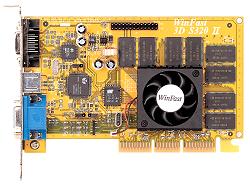
Original Link: https://www.anandtech.com/show/292
Leadtek Winfast 3D S320 II 16Pro TNT2
by Anand Lal Shimpi on May 2, 1999 11:13 PM EST- Posted in
- GPUs
As promised, NVIDIA is delivering their high-speed TNT2 parts at the start of May. The incredible hype which surrounded the release of the TNT2, generated primarily by reports of the elusive TNT2 "Ultra" parts, has built the public's desire for the TNT2 to finally hit the streets. Needless to say, the first manufacturers to offer TNT2 parts will most likely get more than a few impulse sales, but how good of a product will you be getting? Is something better just a week or two down the road? Let's find out as AnandTech takes a look at the world's first TNT2 based product that is available for purchase today, Leadtek's Winfast 3D S320 II.
Feature Overview
Taken from www.leadtek.com:
2D/3D Acceleration
|
Video Acceleration
AGP 4X Sideband Support
|
Configurations Available
| S320 II-16 | 16MB w/ S-Video and Composite TV Out |
| S320 II-16Pro | 16MB w/ S-Video and Composite TV Out, Digital LCD Flat Panel Output |
| S320 II-32 | 32MB w/ S-Video and Composite TV Out |
| S320 II-32Pro | 32MB w/ S-Video and Composite TV Out, Digital LCD Flat Panel Output |
Digital LCD Flat Panel Support
There is no doubt that the next century is the era of All-Digital displays. The WinFast 3D S320 II features DDWG (Digital Display Working Group) compliant Digital LCD Flat Panel output interface for resolutions up to 1280x1024 !
| Specifications |
| Graphics Controller | nVidia RIVA TNT2 |
|
| Memory | 16MB SD(G)RAM or 32MB SGRAM |
|
| RAMDAC | Built-in 300MHz |
|
| Bus Type | AGP (4x/2x/1x) w/ full sideband/Execute mode support |
|
| VGA Connector | DB-15 analog monitor connector |
|
| TV Output | S-Video |
|
| LCD Output - DFP Connector (Optional) | DDWG (Digital Display Working Group) compliant Digital LCD Flat Panel output for up to 1280x1024 resolution |
|
| Vertical Frequency | 60Hz - 240Hz |
|
| Horizontal Frequency | 172.8K |
|
| * The following figures for the throughput of graphics processor are based on the clocking on the right | Chip (TNT) clock |
Memory clock |
*140MHz |
*150MHz |
|
| Fill Rate (pixels/sec) | 250M |
|
| Triangles/second | 5M |
|
| Bandwidth | 2.4GB/sec |
|
* For the purpose of showing outlines of TNT2 throughput, not an indication of driver clocking
| Resolution/Color/Refresh rate Supported |
|
| Bundle Software |
| MPEG-2 (DVD) Player - PowerDVD from Cyberlink 3D Web Authoring tool - WEB 3D from Asymetrix Virtual reality web browser Plug-in - WIRL from Platinum Authoring tool for VRML - VRCreator from Platinum Graphics & Animation Software - 3D/FX from Asymetrix
|
Authoring Tool - RealiMation STE (Demo) from Datapath Internet Browser - Microsoft Internet Explorer Video Editing & Audio Clips Software - Digital Video Producer from Asymetrix Internet Video Playback Plug-in - VDOLive Video Player from VDOnet |
The Card
| The Winfast 3D S320 II is available in four unique configurations, the differentiating qualities among them being memory size and the presence of a digital LCD out port. The card AnandTech will be taking a look at in this review is the Winfast 3D S320 II-16Pro, a TNT2 based part outfitted with 16MB of SDRAM and a digital LCD out port. |
| The card is based upon NVIDIA's reference TNT2 design with a few modifications, such as the addition of a toroidial inductor at the edge of the first SDRAM chip designed to maintain the strength of the electrical current as well as limit the amount of "noise" present in the signal. Other than that particular addition, which shifted the components on the S320-II around a bit, the card is based entirely upon NVIDIA's design and should therefore be much like most other cards that are soon to come. | 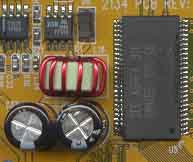 |
The memory configuration on AnandTech's sample, as discussed earlier, was a 16MB setup which was composed of eight 2MB Samsung -G8 SDRAM chips. According to Leadtek, the memory clock should be set at 150MHz, although AnandTech's sample was capable of running the memory at 170MHz. After a few discussions with competing TNT2 manufacturers, it seems like some of the most popular SDRAM suppliers for TNT2 boards will be Samsung, Micron, and a not so well known manufacturer, MIRA. While AnandTech's board, equipped with Samsung -G8 chips made it up to 170MHz, the same may not be true for boards outfitted with non-Samsung modules.
Basically, when it comes to video cards, the manufacturer usually opts for the best deal they can get on memory in large quantities, so if one day Samsung SDRAM grows to be a little more expensive, don't be surprised if board manufacturers turn to other sources for solutions. The only requirement, remember, is to make sure that the memory runs fine at the speed the manufacturer spec'd the board at, and for Leadtek, 150MHz isn't a feat too difficult to achieve.
For the TNT2 itself, Leadtek clocked the processor at a safe 140MHz setting, which is high enough to provide a noticeable improvement over competing 125MHz solutions as well as older TNT and Voodoo2 cards, while low enough to insure proper operation and stability. The 0.25-micron wafers the TNT2 is cut from provide for relatively cool operation, much cooler than the older TNTs and even the new Voodoo3s. They run at a point where a simple passive heatsink would provide adequate cooling for the chip at 140MHz, however it's not surprising that Leadtek went a step further and equipped all members of the S320 II line with a heatsink/fan combo.
The fan operates quietly and performs a decent job of keeping the TNT2 cool, much better than a heatsink alone. Leadtek attached the fansink to the surface of the TNT2 using thermally conductive tape, however for the best cooling performance you may want to replace the tape with a generous amount of thermal grease, the same kind used on CPU heatsinks will do just fine. Using thermal grease (heatsink compound) isn't a requirement, but for all of you tweakers and overclockers out there it may be something you'd be interested in.
The TNT2's integrated 300MHz RAMDAC drives the analog VGA connector on the board that is accompanied by a digital LCD out port on the Pro model as well as a S-video out standard on all models. The 2D image quality of the Leadtek board wasn't bad at all at resolutions up to 1280 x 1024. Upon hitting 1600 x 1200 there was a slight albeit noticeable degradation of the 2D image (depending on how sensitive your eyes are), and each step above 1600 x 1200 also exhibited a similar drop off in quality. The quality of the 300MHz RAMDAC only accounts for half of the 2D image quality equation, the other half coming from the design of the board itself and the quality of the filters between the TNT2/memory and the VGA output. Since the S320 II is essentially a copy of NVIDIA's reference design, the 2D image quality can be considered average for a TNT2 card. Unfortunately, you probably won't ever see what "above average" for a TNT2 card will hold, since there are very few manufacturers willing to risk an increase in manufacturing cost for "awesome 2D image quality," especially not in a world where the term 3D alone sells.
Installation/Software Bundle
The hardware installation portion of the S320 II's setup process is the same as it would be for any graphics card. Unfortunately the beginner or novice user will remain relatively unaided by any helpful diagrams as the User's Manual (like most video card manuals) provides very little in terms of installation help. If you can't install your own video card however, then you may want to re-think plunging into a buying decision such as a brand new TNT2 card.
The software portion of the installation did not provide AnandTech with any problems either, however the drivers Leadtek happens to be shipping with the first cards do have some issues that need to be addressed. First of all, Super7 compatibility with the drivers was not too promising at all, disabling AGP 2X mode aided in increasing stability however the test system experienced frequent crashes under both OpenGL and Direct3D based games.
The performance of the drivers themselves was quite poor, the bundled drivers dated back to a March release and seemed to be optimized for stability rather than performance. Luckily, Leadtek offers the latest drivers for download off of their FTP server, and at the same time, the latest TNT detonator drivers from NVIDIA offer TNT2 support as well. Current TNT owners may want to try Leadtek's TNT2 drivers on their TNT cards for a healthy performance boost, however do so at your own risk.
| A nice feature Leadtek included with the S320 II is an overclocking utility that allows you to set the core frequency and the memory clock of the board in 1MHz increments up to 160MHz core frequency and 180MHz memory clock. In the event that you are able to exceed those two values, an event that is highly unlikely, you'll want to grab Powerstrip and configure the frequencies from there. | 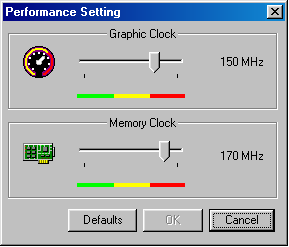 |
Driver Screen Shots

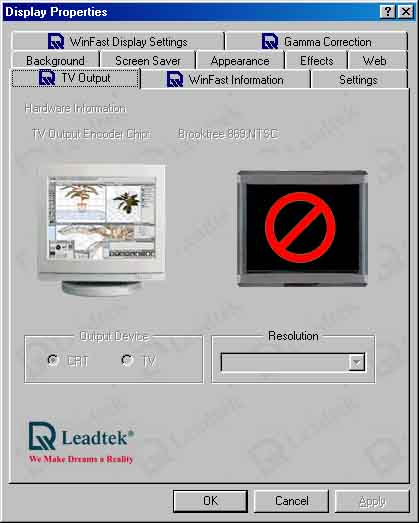
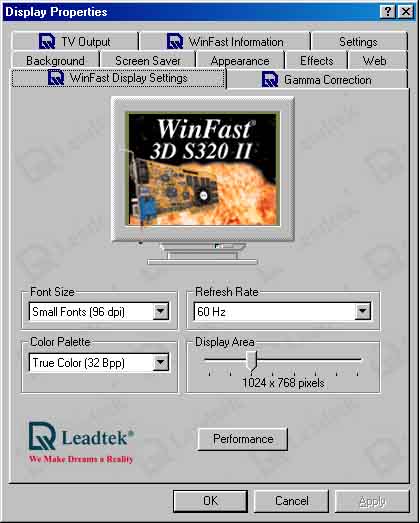
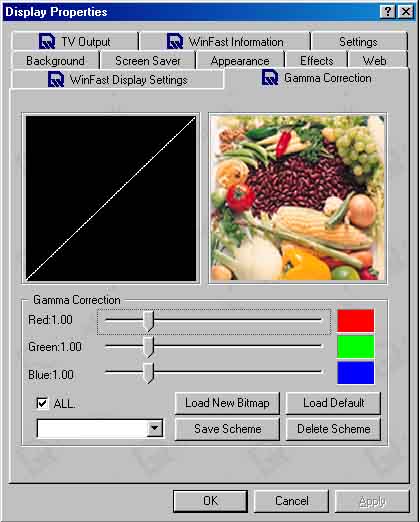
The Test
AnandTech received a pre-release version of Leadtek's WinFast 3D S320 II Riva TNT2 (16MB) card. The card was clocked at 150MHz core and 170MHz memory. For a complete set of benchmarks, see AnandTech's comprehensive NVIDIA Riva TNT2 Review. AnandTech's Slot-1/Socket-370 test configuration was as follows:
- Intel Pentium III 500, Intel Pentium II 400, Intel Pentium II 266, Intel Celeron 333, Intel Celeron 266 (0KB L2) on an ABIT BX6 Revision 2.0 or an ABIT ZM6 for the Socket-370 Celeron 333 tests.
- 64MB of Memman/Mushkin SEC Original SDRAM was used in each test system
- Western Digital 5.1GB Ultra ATA/33 HDD
- Microsoft Windows 98
The benchmark software used was as follows:
- id Software's Quake 2 Version 3.20 using demo1.dm2 and 3Finger's crusher.dm2
- Monolith's Shogo using 3Finger's RevDemo
- Interplay's Descent3 Demo2 using AnandTech's Descent3 Torture Demo
- Ziff Davis' Winbench 99 at 1600 x 1200 x 32-bit color for 2D performance tests
Each benchmark was run a total of three times and the average frame rates taken. Vsync was disabled.
OpenGL Performance
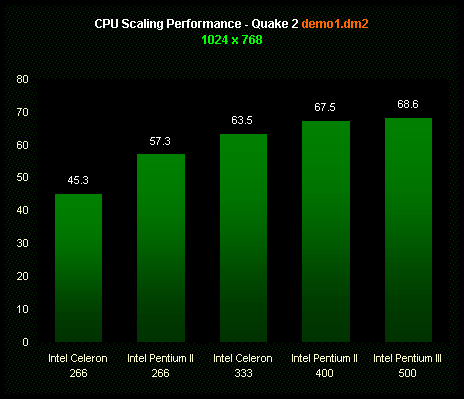
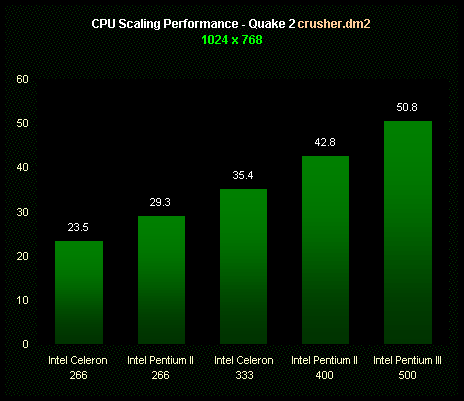
Direct3D Performance
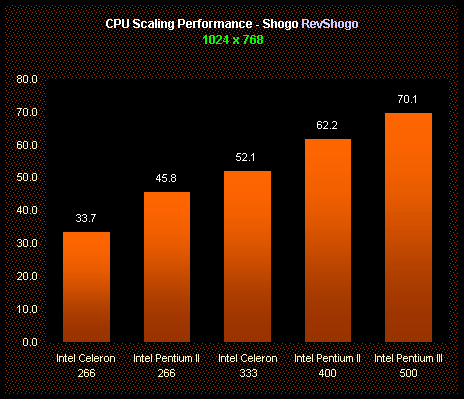
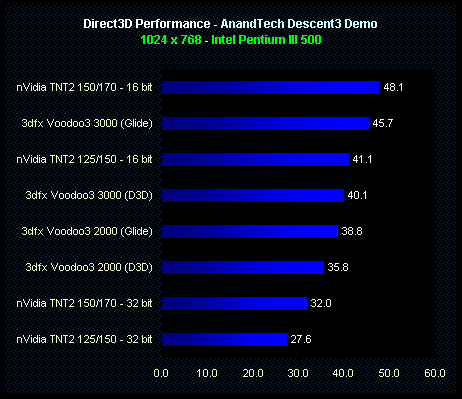
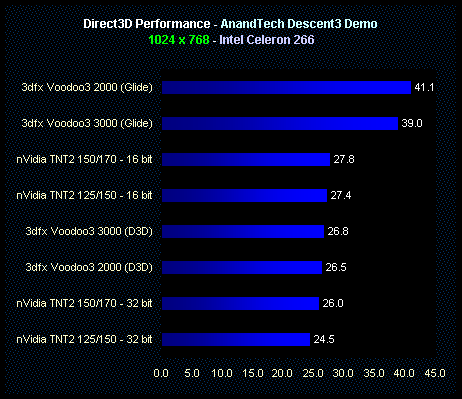
Final Words
By now, the TNT2's performance is known across the world and the decision can be made as to whether or not the TNT2 is the right choice for you. If it is, and you happen to have around $130 burning a hole in your pocket, the Leadtek Winfast 3D S320 II is a perfectly fine choice for a TNT2 card. I can tell you now that the S320 II won't be the absolute best TNT2 card to grace the market, however it won't be the worst, and it's definitely not going to be something you regret for the rest of your life (unless, of course, you wanted a Voodoo3 or a Savage4 instead). The S320 II offers you everything most other upcoming TNT2 cards will, with one value added feature, it's available today.
If you can wait, however, then the wait will be well worth your time as a number of companies will be shipping their TNT products in the coming weeks. Diamond's V770 and their V770 Ultra will be hitting the streets shortly, as will cards from ASUS, Guillemot, and many others. The race for the perfect TNT2 card is just beginning, not to mention the TNT2 pricewars which will soon erupt as more and more manufacturers provide their TNT2 entires into the market. Those that are impatient (or those that are in dire need of a 3D accelerator today) will have no problem going for the S320 II, however the more patient will probably want to wait at least another week or two to see exactly what pops up.

